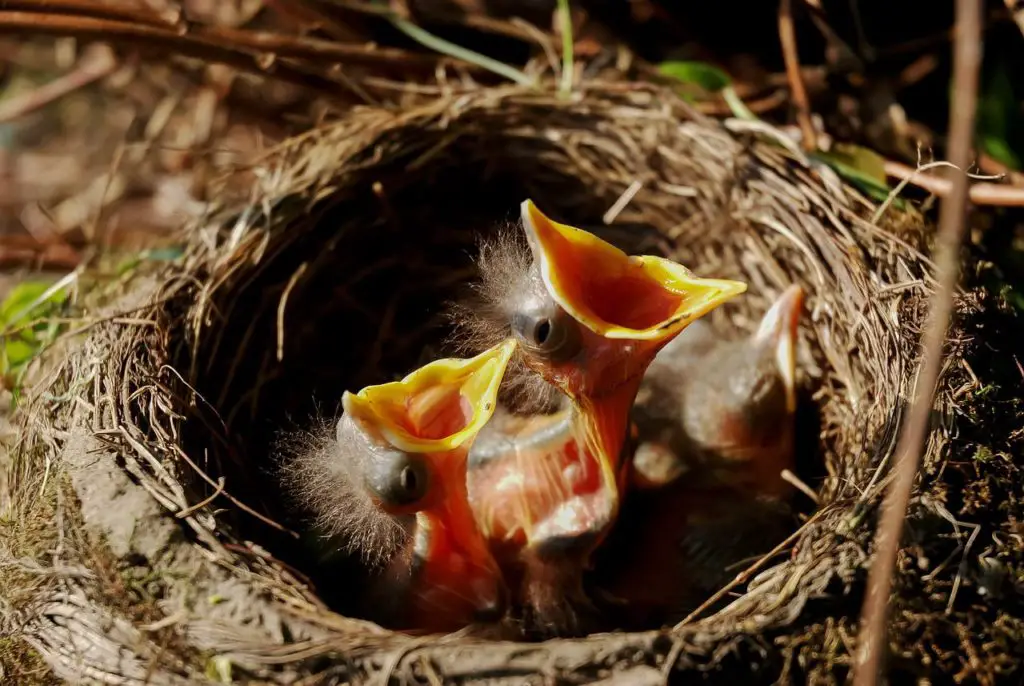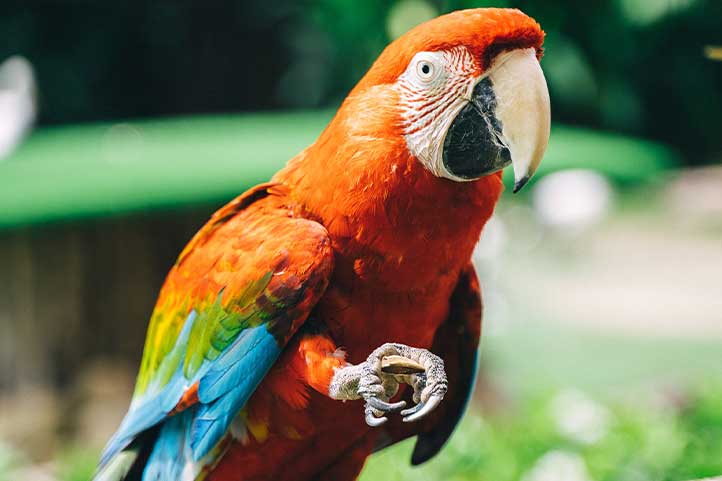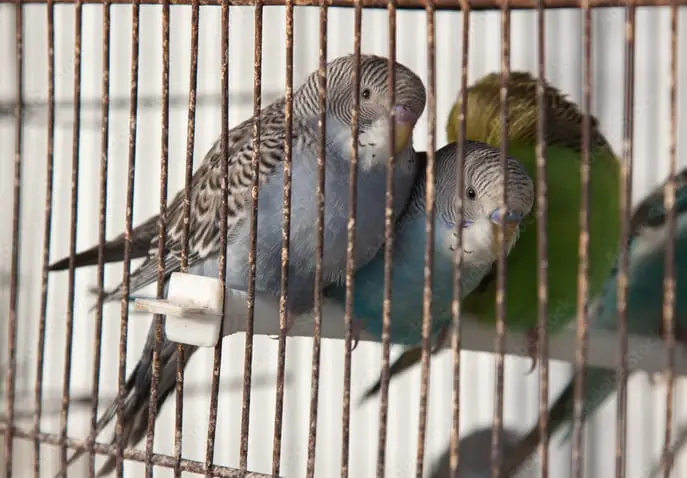Translated by Nick R
An amusing feature of most birds is their ability to build nests, each species having its own style. Below, you’ll learn about the types of nests according to the species of bird you have in your home to give them a space where they feel comfortable.
Table of Contents
Why do birds make nests?
Nature is wise and has evolved in such a way that every species has a different way of surviving.
Nesting is a natural process of birds stimulated by physiological and environmental mechanisms that result in behavioral patterns during courtship, the breeding period, and the laying of eggs, in which birds build nests to house their chicks to ensure their food and protection until they mature.
Birds build their nests with different materials found in their environment, mostly mud and straws, as well as their own saliva. However, some weaver birds create their own fibers from leaves.
In that sense, you’ll understand that, depending on the species and their behavior, the “construction plans” will be different when making their nest.
Types of bird nests
The following are some of the natural bird nest designs in general:
- Adherent: so-called because it is basically attached to walls, rocks, or tree bark. Preferred by swallows.
- Scavenged: the simplest nest. Birds usually create a small, shallow cavity in the ground and add a few stones or feathers. Common in hawks.
- Hanging: this is basically a bag hung on tree branches woven with grasses and plant fibers. Birds of the Ploceidae family weave this type of nest; in fact, one genus of these birds is known as “weavers”.
- Burrow: sometimes these are underground tunnels created by the bird and sometimes using those made by badgers or tortoises. The Burrowing Owl is a species that likes this type of nest.
- Mound: these nests are in the form of a hill, a small mountain of soil, sticks, and branches on the ground. They are made by megapodes or talégalos.
- Platform: it’s usually created by birds of prey and is a large structure on a very durable tree.
- Spherical: A rounded structure completely enclosed by an accumulation of twigs with an opening; imagine it as if it were a ball of branches with a hole in it. This nest is created by species such as the cockatoo cockroach.
So, what are suitable nests for domestic bird species?
Last and not least, the following three are the most common nests in domestic birds.
- Cavity.
- Saucepan.
- Bowl.
Follow me, I’ll explain below…
Types of nests for domestic birds
Birds in the wild or in captivity will need a nest for their young without exception. If you have already read the article on the possession of birds. You’ll know which birds I am referring to.
On the one hand, providing your bird with the necessary natural materials (depending on the species) to build its nest on its own is really important.
On the other hand, in the market for bird accessories, there are also prefabricated nests or materials to make them. Very useful when it comes to species that do not necessarily need to build their nests. Get advice beforehand and buy or look for the right natural materials.
Next, you’ll find out which birds prefer to build their own nests and which ones would prefer you to make them, and you’ll be able to distinguish each nest according to the species.
Cavity nest
This type of nest is preferred by some species of the order Psittaciformes such as:
- Australian parakeets.
- Parrots.
- Cockatiels.
- Lovebirds.
Cavity nests characterize because they are built in trees. As its name indicates, it is a cavity that leads to the interior of a tree, facilitating the entrance and exit of the birds to feed and guard their chicks from up there.
Australian budgerigars don’t require many materials to build their nest as they are very simple and can reproduce in any season of the year. However, they do need a place to raise their chicks, so, in the case of these domestic bird species, it is best to build a nest.
Parrots and cockatoo nymphs will also be very grateful if you build them a good quality nest that provides warmth and security for their developing chicks. Although they have their own defined breeding seasons, these birds have the same nesting behavior as parakeets.

Materials of cave nests
These are the materials you need to make the cavity nest:
- Pieces of plywood: four pieces of 35.5cm x 30.5cm and two other pieces of 35.5cm x 35.5cm. The rectangular box should have an approximate area of 8.40 square meters.
- Tools for cutting, as well as hammers and nails.
- Feathers, straws or shavings for the inside of the nest, where the chicks can perch comfortably.
How to build a cavity nest
The construction of the cavity nest is very simple, follow the steps below:
- Use the 4 smaller pieces of wood to create the side walls.
- Place the two larger pieces, one at the top and then the other at the bottom. In the end, you get an elongated rectangular nest, preferably horizontal.
- Open a hole about 2.5cm in diameter to the front wall of the box. I recommend you open several smaller holes on the sides to give ventilation to the nest, about 1 cm in diameter.
- Insert the feathers, straw, or shavings inside the box.
- Hang the box on one side of the cage.

Bowl-shaped nest
This type of nest is favored by several species of birds of the order Passeriformes, among them:
The bowl-shaped nests are one of the most common nests for birds, they are characterized by being hemispherical and smooth inside a more or less deep cavity where they deposit their eggs and raise their chicks.
Passerine nests evolved from roofed, dome-shaped designs to bowl-shaped nests with a “doorless” entrance. This is because they are mostly small birds of about 13 – 15 cm, so they use their nest to enter and leave it frequently to feed their young.
These species usually like to build their nests, so you can simply provide them with the natural materials for them to “fly their imagination”, or in an extraordinary case, build the nest yourself.
Such birds have an exclusive breeding season or period of the year, because, for example, the goldfinch is a migratory bird. Just like the goldfinch, canaries and zebra finches have a specific mating season.
More information at a click on the name of the species.
Materials for the bowl nest
The materials for bowl nests vary between species, but the materials used are all very flexible and easy to manipulate with their beaks, among them:
- Stems.
- Blades of grass.
- Straw.
- Twigs.
- Moss.
- Mud (in case the bird makes its nest).
- Feathers.
- Lichens.
- Cotton.
- Wool.
- Spider web (optional). If you have the possibility of getting it natural or synthetic, include it.

How to build a bowl nest?
If you finally decide to build the nest yourself, here is the step-by-step for making a standard bowl nest:
- Study the nesting habits of the species.
- Obtain long, flexible stems, branches, straw, blades of grass, moss, etc. You can get the materials in the field (recommended) or purchase materials from a licensed poultry store.
- Build a spherical-shaped loop with the stems, so that you form a basket-like lattice.
- Shape the rest of the nest with grass, straw, moss, twigs, or lichen (or similar commercially available materials) into a circular shape inside and form the cavity to a good depth.
- Introduce feathers, wool or cotton into the cavity to improve the comfort of the chicks.
Saucer-shaped nest
This type of nest is particularly liked by the following species:
- Chickens
- Ducks
Although the gravy boat nest is very similar to the bowl nest, the difference is that it has a shallow cavity, much shallower than the bowl and a less elaborate circular design.
Chickens and ducks hatch, determining the shape of their nests. This means they put their bodies on top of their eggs to keep them warm, so a bowl would be very uncomfortable. Therefore, they evolved to create flatter nests, as their function is more oriented to maintain temperature than to provide protection.
Chickens and ducks are poultry; they generally stay outside the home. So you can leave the material that, in the pens is usually available for the bird to build it or, you can also create it yourself.
Materials for the saucer-like nest
- Grass.
- Straw.
- Branches.
- Feathers.

How to build a saucer-like nest?
Yes, in this case you also do it yourself, this nest is much easier to make compared to the previous ones, here is the step-by-step:
- Get some branches, straw, and grass.
- Build the nest spherically as if it were a dish with grass, branches, and straw.
- Insert feathers, moss, more grass, and straw inside to give it shape. You should not make the cavity too deep (see picture).
Two recommendations:
- You can build the nest inside a crate and add a front entrance.
- Build 1 nest for every 4 females or a maximum for every 6.
Did you know that…?
Birds improve their technique over time. Yes. Despite what was once thought, birds don’t just build nests by instinct, simply because of physiological and environmental issues. Nesting is an etiological process that is related to constant learning. That is to say, birds learn, as they build more and more nests their technique presents modifications, demonstrating greater expertise in their next nest with respect to the previous one. Surprising, isn’t it?
So here’s the end. You’re now an expert nester and as you could see birds are amazing architects.
You may be interested in…
What birds can I keep as pets?


